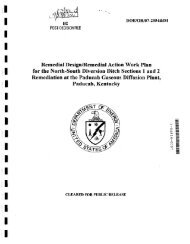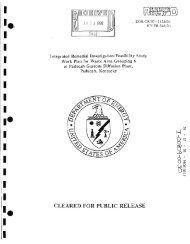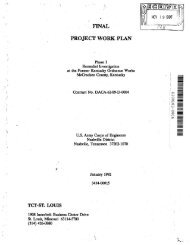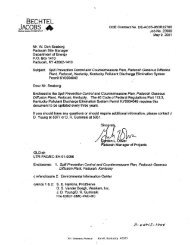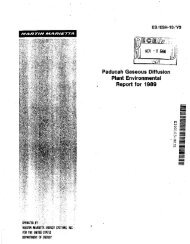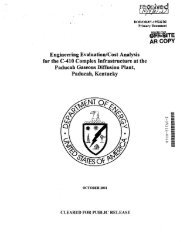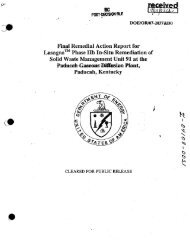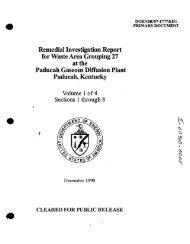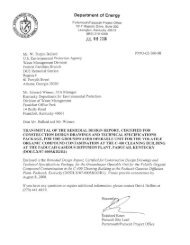1 - paducah environmental information center
1 - paducah environmental information center
1 - paducah environmental information center
Create successful ePaper yourself
Turn your PDF publications into a flip-book with our unique Google optimized e-Paper software.
Paducah Site<br />
The WAG 8 SE consisted of five sites<br />
within the PGDP that were considered a potential<br />
source for PCBs. Four of the five sites are<br />
electrical switchyards, while the fifth site is an<br />
abandoned UP 6 conversion facility. The five<br />
sites were SWMU 82, the C-531 Electrical<br />
Switchyard; SWMU 83, the C-533 Electrical<br />
Switchyard; SWMU 84, the C-535 Electrical<br />
Switchyard; SWMU 85, the C-537 Electrical<br />
Switchyard; and C-340 Reduction and Metals<br />
Facility. Table 3.2 lists the total number of<br />
samples collected at each WAG 8 SWMU and<br />
building by media.<br />
Soil and water samples were collected and<br />
analyzed for VPCs, SVOAs, PCBs, metals, and<br />
radionuclides. ..An on-site screening of alpha,<br />
beta, and gaIDma activities was used to identify<br />
the samples that might require radioisotopic<br />
analysis in a fixed-base laboratory. The<br />
analyzed radioisotopes were .241 Am, 237Np,<br />
239Pu, and 239/240Pu.<br />
Several SVOAs, radionuclides, PCBs, and<br />
dioxin/furans were detected in the. surface soil<br />
samples collected from the drainage ditch at<br />
SWMU 82. Detections of PCBs, at a maximum<br />
concentration of 1,183 mg/kg, and dioxin!<br />
furans, at a maximum concentration of 25,200<br />
picograms/gram (pg/g), represent residual<br />
contaminants from historical leaks and spills at<br />
the site. Low levels of SVOAs are known to be<br />
ubiquitous to PGDP, and radionuclides are not<br />
process-related to the electrical switchyards. No<br />
COCs were detected in the subsurface soil at<br />
SWMU 82.<br />
Surface soil samples collected in the<br />
drainage ditches at SWMU 83 contained low<br />
concentrations of several SVOAs (maximum<br />
concentration only slightly above the method<br />
detection limit). Several metals (aluminum,<br />
beryllium, nickel, vanadium, iron, and<br />
magnesium) were detected in the subsurface at<br />
concentrations that only slightly exceeded<br />
background levels.<br />
Several SVOAs, l37Cs, PCBs, and dioxin!<br />
forans were detected in the surface soil samples<br />
collected from the drainage ditch at SWMU 84.<br />
Detections of PCBs, at a maximum concentration<br />
of 380 mg/kg, and dixoinlfurans, at a maximum<br />
concentration of 6790 pg/g, represent residual<br />
contaminants from historical leaks and spills at<br />
the site. No site-derived contaminants were<br />
detected in the subsurface soil at SWMU 84.<br />
Several SVOAs, PCBs, and dioxin!furans<br />
were detected in the surface soil samples<br />
collected from the drainage ditch at SWMU 85.<br />
Detections of PCBs, at a maximum concentration<br />
of 71 mg/kg, and dioxin!furans, ata maximum<br />
concentration of 9,180 pg/g, represent residual<br />
contaminants from historical leaks and spills at<br />
the site. No site-derived contaminants were<br />
detected in the subsurface soil at SWMU 85.<br />
At SWMU 82; 83, 84, and 85, only a small<br />
quantity of 99Tc (23.4 pCi/L, 17.4 pCi/L, 17.9<br />
pCiIL, 16.2 pCi/L, respectively) was detected.<br />
99Tc is not a process-related contaminant at the<br />
electrical switchyard; therefore, site-derived<br />
contaminants are not being transported offsite<br />
via the storm water migration pathway. The lack<br />
of site-derived contaminants in the subsurface at<br />
each of the four SWMUs indicates the leaching<br />
of contaminants from the soil to groundwater is<br />
not a significant contaminant migration pathway.<br />
Contamination in the C-340 Building<br />
consists of radiological and chemical<br />
contaminants remaining from the uranium metal<br />
production process previously performed in the<br />
building. Documentation pertaining to releases<br />
is not available, but it is likely that some of the<br />
process feedstock, product material, byproducts,<br />
uranium metal scraps, sludges, and<br />
ancillary materials could have been carried<br />
outside the building during process spills<br />
through the building ventilation and drainage<br />
systems. Surface soils at the C-340 Building<br />
contain elevated levels of SVOAs, PCBs,<br />
dioxins/furans, metals, and radionuclides over<br />
most of the site. Polycyclic aromatic<br />
hydrocarbons (P AHs) are present at<br />
concentrations in excess of 100,000 mg/kg.<br />
3-10<br />
Environmental Program Information



